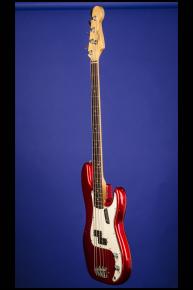An Exceptionally Fine Pre-CBS Custom-Color Precision Bass
1965 Fender Precision Bass
This 13-inch-wide lightweight pre-CBS precision bass weighs just 8.60 lbs. and features a solid alder body, contoured on the back and lower bass bout. One-piece maple neck with a nut width of 1 3/4 inches, a full bass scale length of 34 inches and a very fast thin-to-medium profile. Veneer rosewood fretboard with 20 original medium frets and clay dot position markers. Headstock decal with Fender 'transition' logo in silver with black trim, "Precision Bass" in black below it, and four patent numbers "PAT 2,968,204 2,976,755, 2,573,254 DES 187,001" beneath the logo. Fender cloverleaf tuners and single circular string tree. Four-bolt neck plate with serial number "L64487" between the top two screws. One split black eight-polepiece pickup with a great, fat output of 12.35k. Three-layer white over black plastic pickguard with thirteen screws. Two controls (one volume, one tone) on the lower treble bout. Chrome knobs with knurled sides and flat tops. Combined four-saddle bridge/tailpiece with 'grooved' saddles. Complete with both the original bridge and pickup covers, the original thumbrest on the treble side of the pickguard, and the metal shield under the pickguard. The neck is stamped "5 FEB 65C" and the pots are stamped "304 6512" (Stackpole March 1965). This beautiful custom color bass is in exceptionally fine (9.00) condition. There is some very fine finish checking on the body, mainly on the back, and a few small surface chips, mainly on the sides. The back of the body by the four-bolt neck plate shows some slight indentation (from the screws being over-tightened?) Otherwise, this is an exceptional and totally original example of a pre-CBS in the earlier 'Candy Apple Red over Silver' Precision Bass, and is one of the best playing and sounding Basses that we have ever heard! Housed in its original Fender three-latch, rectangular black hardshell case with reddish orange plush lining (8.75).
Although this guitar has a neck date of February 1965 and potentiometer dates of March 1965, it has all the features of a 1964 example including the 'clay' dot markers and only four patent numbers on the headstock. The 'clay' dot markers were changed to 'faux pearl' dots and the patent numbers were increased from four to five.
The Precision Bass, with its revolutionary new shape, was launched in 1951, and originally had a slab body. It was not until 1954, with the introduction of the Stratocaster, that Fender contoured the body. All early Precision Basses had one-piece maple necks, but in 1959, a slab-board rosewood fretboard was introduced, and then finally in 1962 the "veneer" rosewood fretboard was introduced.
Until the Precision, the bass was an upright acoustic instrument that was difficult to hear and cumbersome to transport. Leo Fender's invention allowed musicians to hold their instrument like a guitar, opening the bass world to curious guitar players, and allowing bass players a level of freedom they had not yet encountered. Due to the bass's solid body construction, it could be amplified to any level, giving it new found aural presence. In its first fifteen years of development, the Precision Bass changed as much as the music it influenced and the musicians it inspired, having been played by everyone from The Shadows to Led Zeppelin.
"Candy Apple Red (CAR), first introduced in 1963, was alleged to be Leo's favorite custom color, and hence was a very popular Fender color. It was also a "true" custom color. CAR was not simply a 1960's car color used on guitars. It was an actual custom finished used by Fender and custom paint shops. It was certainly the most difficult color for Fender to apply since it required an additional step of using a metallic base-coat before a translucent red color coat. All other metallic Fender finishes have the color and metallic particles mixed together into a single paint unit. "Candy" colors have a metallic base coat applied first. This is followed by a translucent color coat, and finally by a clear coat. This gives a much deeper metallic look to the finish because the color is not mixed with the metallic sparkles. The metallic particles shine through the translucent color coat instead of being surrounded by the color which stifles their effect. Also by separating the metallic particles and color, larger metallic particles could be used in the base-coat. This also enhanced the metallic effect. Fender typically used a white primer under the metallic base-coat to limit the amount of basecoat needed. The base coat used by Fender was usually silver until 1965/1966, and gold starting some time in 1966. The final finish looks slightly different depending on the color of the base-coat. Gold base-coat makes the CAR look more maroon and turns brownish-red with age. Silver is the much cooler base-coat as the color is more red than maroon and ages better." (http://www.guitarhq.com/fenderc.html)















